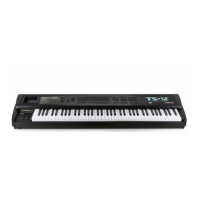Section 2 — System Page Parameters TS-12 Musician’s Manual
10
• JAVA-PELOG1 — One of the two main scales of the gamelan orchestras of Java and Bali is the
seven-tone scale called Pelog. The notes C, D, F , G, and A (which are reproduced on the black
keys) are considered primary, with E and B used for grace notes. The octaves are stretched
(tuned a little sharp) due to the harmonic content of the instruments in the gamelan. (Note
that there are many subtle variations of these tunings, almost as many as there are gamelan
ensembles. The tunings we have included here are to be considered typical, not definitive.)
• JAVA-PELOG2 — This is another version of the seven-tone Pelog scale used in gamelan
music. The notes C, D, F , G, and A (which are reproduced on the black keys) are considered
primary, with E and B used for grace notes. The octaves are stretched (tuned a little sharp)
due to the harmonic content of the instruments in the gamelan.
• JAVA-PELOG3 — A third version of the seven-tone Pelog scale used in gamelan music. The
notes C, D, F , G, and A (which are reproduced on the black keys) are considered primary,
with E and B used for grace notes.
• JAVA-SLNDRO — This is a 15-tone equal tempered tuning from Java. Playing every third
note (as in a diminished chord) yields a typical 5-tone scale of the gamelan. Other notes can be
used as passing tones.
• JAVA-COMBI — This is actually two pitch-tables in one. The white keys play the seven-tone
Pelog scale, same as the table JAVA-PELOG1. The black keys play a five-tone scale called
Slendro, which is close to a five-tone equi-tempered scale. Both tunings have their octaves
stretched (tuned a little sharp) due to the harmonic content of the instruments in the gamelan.
• INDIAN-RAGA — Indian scale used to play ragas, based on 22 pure intervals called Srutis.
This pitch-table uses two keyboard octaves to play one octave in pitch. The 22 Srutis are
mapped to keys in this two octave range omitting the A#s, which play the same pitch as the
adjacent A.
• TIBETAN — This tuning is based on a pentatonic scale from Tibet. Notice that playing the
black keys yields a scale similar to the 5-tone Slendro tuning from Indonesia.
• CHINESE-1 — This is a seven-tone scale used widely in China. It is meant to be played on the
white keys.
• CHINESE-2 — This is a seven-tone scale based on an ancient Chinese lute tuning. It is meant
to be played on the white keys.
• THAILAND — This is a seven-tone equi-tempered scale from Thailand. It is meant to be
played on the white keys.
• 24-TONE-EQU — Centered on C4, this scale has an even quarter tone (50 cents) between each
keyboard note, and each pitch octave covers 2 keyboard octaves. This tuning has been used
by many contemporary composers and can be used in some Middle Eastern music.
• 19-TONE-EQU — Centered on C4, this scale divides the octave into 19 equal steps. From C4
to G5 forms an octave. This scale yields very pure thirds and sixths, but not fifths. Like the
24-tone scale, this has been used by some modern composers.
• 31-TONE-EQU — Centered on C4, this scale divides the octave into 31 equal steps. From C4
to G6 forms an octave. Similar to 19-tone in the purity of its intervals.
• 53-TONE-EQU — This scale divides the octave into 53 equal steps. From C2 to F6 forms an
octave. It yields very pure thirds, fourths and fifths.

